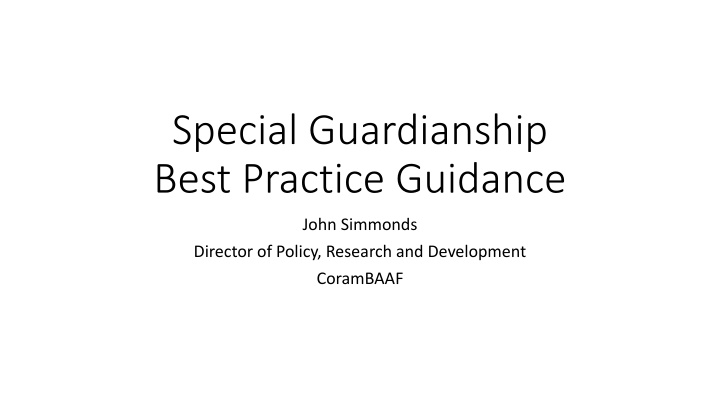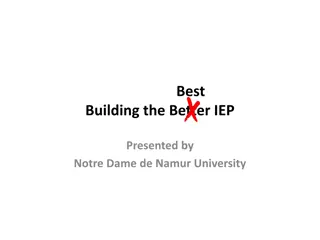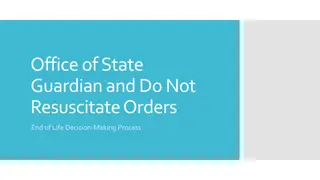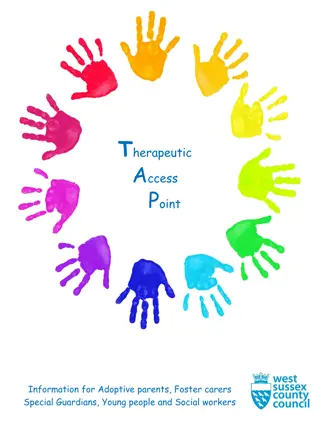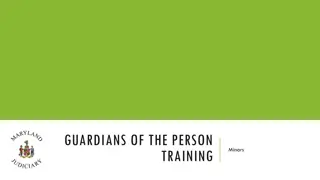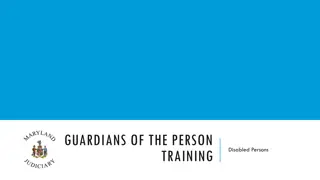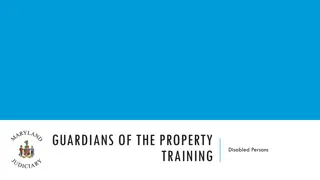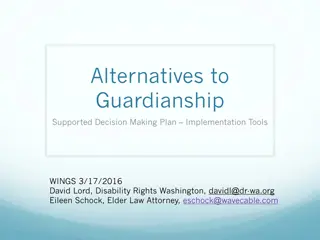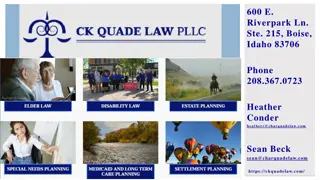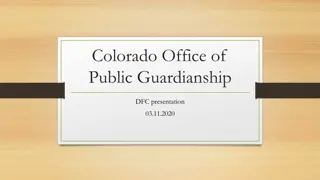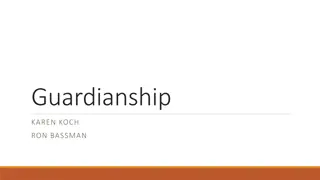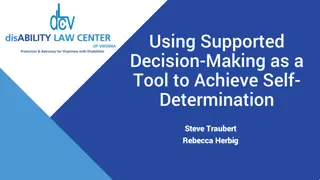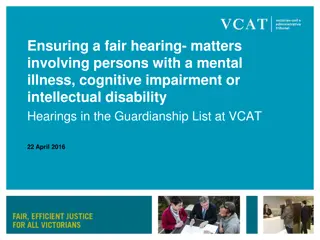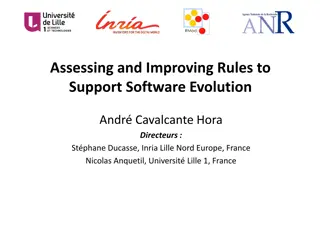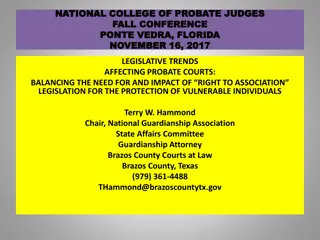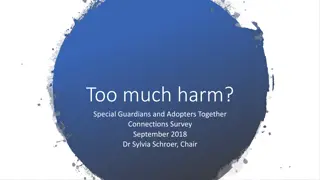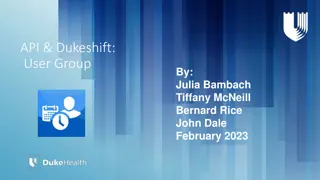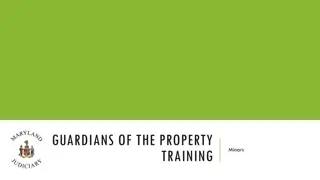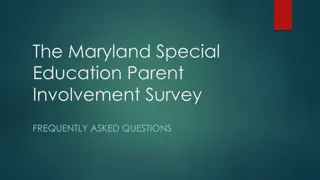Evolution of Special Guardianship and Best Practices Guidance
Special Guardianship emerged as a permanency option in the late 1990s to provide a solution for children for whom adoption was not suitable. It evolved to include older children, unaccompanied asylum-seeking children, and those from cultural/religious communities rejecting adoption. Special Guardianship facilitates placements with family members, requiring court oversight to ensure suitability and match with the child. Recent reviews enhanced regulations to consider harm suffered by the child and prospective guardians' parenting capacity.
Download Presentation

Please find below an Image/Link to download the presentation.
The content on the website is provided AS IS for your information and personal use only. It may not be sold, licensed, or shared on other websites without obtaining consent from the author.If you encounter any issues during the download, it is possible that the publisher has removed the file from their server.
You are allowed to download the files provided on this website for personal or commercial use, subject to the condition that they are used lawfully. All files are the property of their respective owners.
The content on the website is provided AS IS for your information and personal use only. It may not be sold, licensed, or shared on other websites without obtaining consent from the author.
E N D
Presentation Transcript
Special Guardianship Best Practice Guidance John Simmonds Director of Policy, Research and Development CoramBAAF
Originally identified as a further permanency option to adoption as a part of a major review in the late 1990 s and early 2000 s Suggested applicability Older Children Unaccompanied asylum-seeking children Children whose cultural/religious communities did not accept adoption as an acceptable solution The Evolution of Special Guardainship
Developed towards the placement of children under 5 with family members as a resolution of care proceedings. Th extent to which those family members had a relationship with the child or had substantial caring experience of the child varied enormously. The processes available to local authorities and the courts was not well aligned with other routes to permanence particularly adoption or long-term foster care. In adoption and foster care, the suitability of carers and the match with the child is dealt with by the local authority. The court s responsibility is to authorise the most appropriate legal order for the child. Special Guardianship enables/requires both processes to be addressed by the court. Have The courts have become a family placement agency when this was never identified in the original objectives for Special Guardianship? The Evolution of Special Guardianship
Adoption & Special Guardianship Orders 6000 5360 5050 4710 5000 4370 4010 3870 3860 3850 3720 3700 4000 3550 3470 3360 3330 3200 3100 3590 3460 2780 3000 3440 2150 1780 2000 1290 1240 1000 0 2009 2010 2011 2012 2013 2014 2015 2016 2017 2018 2019 2020 Adoption Special Guardianship https://explore-education-statistics.service.gov.uk/find-statistics/children-looked-after-in- england-including-adoptions/2020
Review of Special Guardianship The Department for Education undertook a review resulting from widespread concern about the robustness of due process particularly the assessment of suitability as set out by regulation The findings of the review reinforced the positive option of Special Guardianship. Amendments were made to the regulatory framework to require due consideration to be given to any significant harm that the child had suffered and the parenting capacity of the prospective special guardians to address those issues in their care of the child. The amendment was then placed in primary legislation as Section 8 of the Children and Social Work Act 2017 and applied to any child subject to a Section 31A plan.
Re P-S (Children) 18.6.2018 The specific resolution of the matters subject to appeal were expanded to the identification of a range of issues that were commonly reported across both the courts and local authorities in relation to Special Guardianship. The urgency of resolving these issues was summed up in the judgment: There is a real need for authoritative guidance to sit alongside the statutory materials. I therefore propose to invite the Family Justice Council to undertake this task (prepare authoritative guidance) and to make available to it all the research and other relevant materials which were put before us. (para 70 and 71)
Authoritative Guidance Rapid Evidence review commissioned by the Nuffield Family Justice Observatory undertaken By Judith Harwin and John Simmonds Incorporated into the review of the Public Law Working Group. Publication of the PLWG chapter on special guardianship including Best Practice Guidance on Special Guardianship was published in summer 2020.
Best Practice Guidance - Basics The Placement of a Child/ren where they have met the threshold of significant harm must be evidence and experienced informed. Placement and the legal order that enables this is a life changing and life enhancing that will impact on the child for 80-90 years. The placement of the child and the making of the order is only the beginning. There are likely to be multiple issues that evolve over time, within the family as there are in every family. The challenges are likely to be more prominent where children have experienced abuse and/or neglect.
Stage 1 The escalation of child protection concerns and the child protection plan to the decision by the local authority to issue care proceedings The challenge in engaging the wider family What they know and what they don t knowabout the local authority s involvement. How they think and feel about what they come to discover? How this impacts on family relationships shock, dis-belief, anger, blame, anxiety, fear. Responding to the immediate issues of the need to care for the child within the family who, when and how? Engaging with the local authority in a constructive and meaningful way to identify answers/solutions in the emerging crisis of care proceedings
The plan to place the child Where an agreement is reached to place the child/ren The carers need to be fully informed of the detail of the child being placed with them The legal framework that enables the placement. What is known about the child s health, development, and needs from 24/7 routines to longer term issues and more specific issues such as treatment for addictions, low birth weight, responses to trauma, identified disabilities or blood born viruses. The concerns/questions of the family members as carers and the sufficiency of their approach to parenting. Access to health, legal, education and social work advice and support.
Access to resources Practical issues such as clothing, hygiene, beds and bedding, feeding, toys Relational issue such as family time with parents and other priority people Parenting support including the provision of specific programmes to develop specific skills Financial and housing resources including safety in the home, employment, pets
The Timeline Integrating the local authority s engagement with the family members who agree and are identified as being suitable for care for the child in the immediate and short term with the long-term care plan for the child is extremely challenging and variable. For some, the prospective carers they may know the child well and have cared for the child through family arrangements and agreements. For others, none of this may be directly experienced based. The key issue is that in every case, the special guardians will need a specific evidence-based plan that takes into account the needs of the child and those of the carers. The plan will need to evolve on the basis of actual experience what works well and what needs further exploration and resolution.
Issues for the Court The courts duties and responsibilities to resolve the matters set out in the application will be a combination of the evidence in relation to the: The welfare checklist and related matters, The threshold for significant harm, The local authority s care a plan for the child. Where Special Guardianship is the identified legal order for the resolution of those proceedings, the court is faced with a major challenge. Resolving not only the question of what the plan for the child should be (as is the case of adoption) but whether the plan for the child is working based o robust evidence, drawn from substantial experience.
Best Practice Guidance Recognises the serious challenge and responsibilities faced by the court, the local authority, the carers and the child amplified by the legal responsibility to complete proceedings within 26 weeks unless a lawful extension is granted Identifies the fundamental importance of evidence, experience and the child s development over time as the child settles into placement with the prospective special guardians. Does this Return us to the legal requirement in the Act which describes the Order as a private law application requiring one year of caring for the child before an application can be made?
Best Practice Guidance Recognises that the plan for the child and the making of the order needs to addressed on an individual case by case basis. In some cases, the evidence may be sufficient to make an order where the child has been in placement for 3 months. In other cases, the child may need to be in placement for 12 months. Whatever timescale is appropriate, the welfare, needs and development of the child by the prospective special guardians must be the primary focus as set out in law. Nothing else will do!
